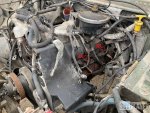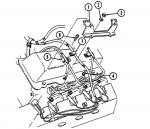- 1,341
- 1,930
- 113
- Location
- Las Vegas Nevada
Steel Soldiers now has a few new forums, read more about it at: New Munitions Forums!

I think you are talking about the elbow between the snorkel and the air canister?I had the air canister off when I did the injection pump and the elbow that you can’t see was torn apart. Might be a good thing to check because rain water would’ve run into it. I really like my air canister now. I took that inner part out to give it more airflow.View attachment 888834View attachment 888835
I never would’ve checked if not for replacing my injection pump. I have had so much help from members here. I never would have had the confidence to do it without them. I don’t know anything about diesels or Humvee’s. The TM’s are really helpful but nothing like being able to ask a question.I think you are talking about the elbow between the snorkel and the air canister?
This truck came with all three parts removed.
First thing I did when picked it up, I covered the exposed intake, then after I brought it home I cleaned the oil from inside and vacuumed it. I used a previous, clean canister to start it as I didn’t want to let impurities getting into the intake.
From day one the truck has been inside the garage and didn’t get any water, besides when I washed the engine (with the intake covered), and I understand what you if the elbow was ruptured and water was getting inside.
I totally agree! I am in a similar position with no previous experience and exactly like you said, the guys on the forum are beyond fantastic!I never would’ve checked if not for replacing my injection pump. I have had so much help from members here. I never would have had the confidence to do it without them. I don’t know anything about diesels or Humvee’s. The TM’s are really helpful but nothing like being able to ask a question.
I don’t think that’s even possible? Nothing filters out sand like paper. How come modern vehicles don’t have complete obstructions if it’s a possibility? I think it’s to deflect water and not DirtThe purpose of that plate you removed from inside the canister is to deflect sand/grit from hitting straight onto the paper air filter at high speed. Without it there if you operate in dusty/dirty conditions you may eventually sandblast a hole right through the paper filter element, and then into your intake.
Open it up and look at it. It’s built to channel water down to the drain at the bottom. My truck has a block off at the bottom and not the duckbill. It’s a major restriction and my truck doesn’t need it. Everyone can do whatever they think is best. This works for meYou could both be right, I am no expert in intake design, and as a power design engineer where air flow is critical in cooling power semiconductors, it seems like that internal air guide or diffuser was perhaps meant to spread the air across more of the air filter area, while it may marginally reduce air flow, it increases the usable air filter area and maybe its overall efficiency, which maybe it’s a calculated trade-off…just a thought.
EDIT: typos


Yes, it will deflect water also to keep the filter dry, but there should be an intake cap that prevents water from getting into the system in the first place.I don’t think that’s even possible? Nothing filters out sand like paper. How come modern vehicles don’t have complete obstructions if it’s a possibility? I think it’s to deflect water and not Dirt
Do you have an exploded view of the GM7 turbo? I am trying to understand where the oil input feed is coming from and where it is going and the overall internals.#8 looks like a snow man.
Thank you!It is base fed and you have a supply and return hole and that’s why gasket looks like an 8
Just goes in the base and lubes the bearings and shaft.
I appreciate the details, it’s exactly what I am trying to understand. Someone here on the forum that had a similar blow-by problem suggested that I look into that turbo cartridge and I wanted to fully understand for myself how the whole thing works in case I get different results than expected and where to go from there.The 2 holes in the middle are the oil supply (big) return is smaller. At least that’s how it seemed when I started my truck with the turbo off. View attachment 889135
Yes, found some on ebay, they are all Chinese, ranging from $155 to $200. In fact to give credit where is due, another forum member pointed me to it and that’s what he’s using.They are the bolt holes that hold it to the engine block. I looked at new cartridges and I don’t think they are very expensive
desDo not just start replacing parts just because someone suggests it, troubleshoot your problems to the defective component, with a recent rebuild it is very doubtful you have a defective turbo.
One of the biggest mistakes a HMMWV newbie makes is just to start throwing money away swapping out parts with no knowledge that the part is actually defective, we see this time and time again on this forum.
MANY times this causes additional problems or compound the real issue or there was no real issue at all.
You cannot possibly have enough road miles on this HMMWV to insure that the blow-by is an actual problem.
I honestly do not see any way a defective turbo could cause excessive blow-by.
A defective turbo could fail and cause excessive oil burning by dumping oil into the intake or exhaust or possibly excessive diesel smoke under load due to it being seized.
I totally agree with everything you said. The reason I am asking all these questions is to not do exactly what you described, creating additional issues where there may be none, or something minor, besides throwing money out the windowDo not just start replacing parts just because someone suggests it, troubleshoot your problems to the defective component, with a recent rebuild it is very doubtful you have a defective turbo.
One of the biggest mistakes a HMMWV newbie makes is just to start throwing money away swapping out parts with no knowledge that the part is actually defective, we see this time and time again on this forum.
MANY times this causes additional problems or compounds the real issue or there was no real issue at all.
You cannot possibly have enough road miles on this HMMWV to insure that the blow-by is an actual problem.
I honestly do not see any way a defective turbo could cause excessive blow-by.
A defective turbo could fail and cause excessive oil burning by dumping oil into the intake or exhaust or possibly excessive diesel smoke under load due to it being seized.
We get it, advertisements are annoying!
Sure, ad-blocking software does a great job at blocking ads, but it also blocks useful features of our website like our supporting vendors. Their ads help keep Steel Soldiers going. Please consider disabling your ad blockers for the site. Thanks!
